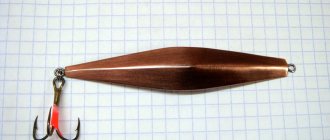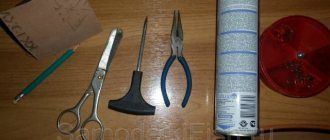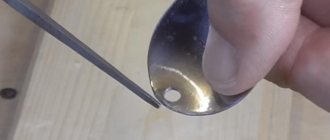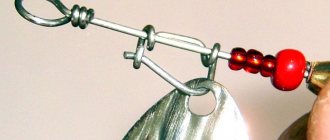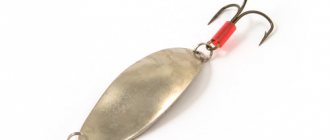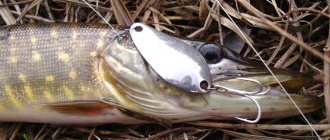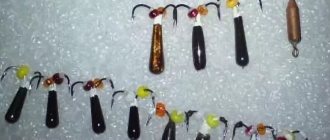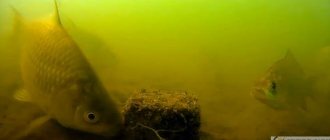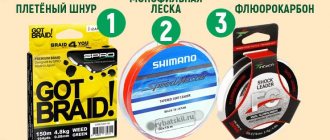Today you can buy almost everything in fishing stores. But sometimes fishermen have requests that even the modern fishing industry cannot provide.
This may be due to specific fishing conditions or increased interest of the predator in a certain type of bait in a particular body of water, as well as the high cost of factory products. Then skillful hands come to the rescue. One of the most catchy homemade baits is a do-it-yourself pike perch spinner made from a tube. Otherwise, tube spoons are called “slices” .
Types of tubular spinners
- Hollow spinner. Made from a piece of metal tube.
- Spinner with a sealed top. The upper end of the spinner is sealed with lead. Such a spinner has a different game, more sweeping or yawing, since when retrieved its front end resists the aquatic environment. In addition, the back hollow part of the spoon emits acoustic vibrations of a certain frequency that attract pike perch.
- Loaded spinner. The front part of the spoon is filled with lead by a third or half. Such baits are used if a significant casting distance is required.
- Noise spinner. One or more lead pellets or steel balls are placed into the cavity of the spoon, and the spoon itself is sealed at both ends.
- Composite spinner. Made from three pieces of tube. Has a very active game and has good catchability.
Fishing with a drag
Scheme of rigging for haul fishing
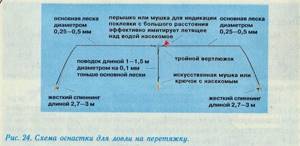
Correct rig position when playing with a fly
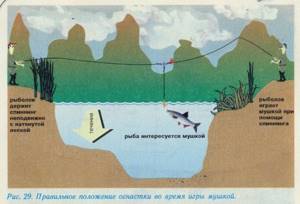
Second stage of gear setup
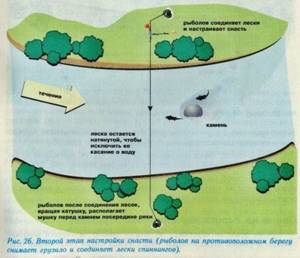
Scheme for fishing in a wade using a constriction
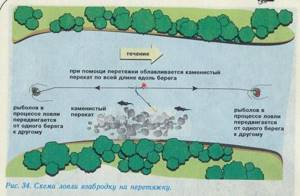
Scheme for fishing with a looped constriction without an assistant
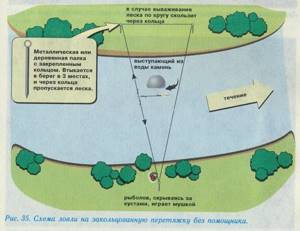
Scheme of fishing with a constriction with a rubber shock absorber
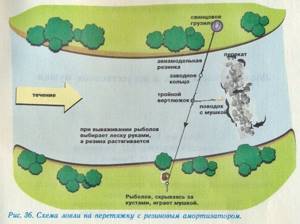
Manufacturing
To make a tube spinner for pike perch at home, the craftsman will need:
Tools:
- hacksaw for metal;
- file;
- vice;
- sandpaper;
- drill with thin drill bits.
Materials and accessories
The material used is aluminum or copper tubes of the required diameter . It should be remembered that the specific gravity of copper is almost twice as high as that of aluminum, and be guided by this when making bait.
Lead is necessary in the manufacture of the corresponding types of spinners.
Winding rings are used to attach hooks to the lure.
Treble hooks are a necessary element of the spinner equipment.
Process
- Preparation of the workpiece. Using a hacksaw for metal, a piece of tube of the required length is cut. The smallest spoons have a length of 50 mm and show excellent results when catching pike perch in the wilderness. The most commonly used lures are 70 mm long, although spinners 100-110 mm long are also quite common. The cutting angle of the front part (the one where the fishing line is then attached) of the spoon is 30-60 degrees (usually about 50), the rear part (the place where the tee is attached) is 20-25 degrees.
- Workpiece processing.
The edges of the cuts are cleaned with a file and then with sandpaper. - Drilling holes.
Holes with a diameter of 1-1.5 mm are drilled in the front and back of the spoon. - Equipment with tees.
Winding rings are threaded into the holes, to which, in turn, tees are attached. - Loading the spinner.
The manufacture of tube spinners of another type includes the same steps; the process only includes soldering the front part for a bait with a sealed front end, or adding acoustic elements followed by soldering for noise spinners. If you need to make a loaded spoon, then its front part is filled with lead by a third or half.
Expert opinion
Knipovich Nikolai Mikhailovich
Zoologist, hydrobiologist. I am interested in fishing at a professional level.
Interesting! Most anglers make a hole in the front of the spoon at its “far” end, so to speak. But if you drill a hole on the near part of the cut, the game of the bait changes significantly, which can be useful when catching a passive predator.
Making a composite spoon-tube
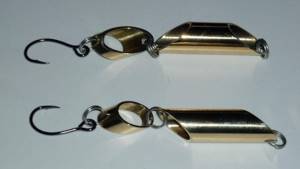
The manufacturing process is more complex. It consists of the following steps:
- Cut out a piece of tube 80 mm long and make cuts at its ends in the same way as when making a regular tubular spoon.
- Cut the workpiece into three parts, maintaining the same angles as on the initial workpiece.
- They make special “ears” - protrusions designed to connect the segments to each other. This is a very painstaking job and is done with a file.
- Drill holes at the front and rear ends of the tube and in each eye.
- Connect the three parts of the bait using rivets.
- The lure is equipped with rings and tees.
The sizes of the segments can be of different sizes : the decision remains with the master. You can also use various metals in the manufacture of bait components.
Additional features
What remains is tuning the tube spinner. Most often, anglers use a tee equipped with an artificial fly . The latter serves to stabilize the play of the spinner during retrieval and is an additional element that attracts predators. Sometimes, instead of a tee, a single hook equipped with a twister . When fishing in winter, it is highly advisable to put 2-3 multi-colored cambrics or use a hook with a three-color drop.
Installation and gear elements
To catch ide by dragging, you will need two spinning rods equipped with spinning reels, a main line and leashes with hooks.
It is appropriate to use light and medium-light forms with dough from 7 to 14 and from 14 to 18 grams. The main line connecting paired spinning rods must have a diameter of at least 0.4 mm. The length of additional leads is from 20 to 40 cm, the diameter of the fishing line is from 0.15 to 0.25 mm. They are tied to the main line through swivels. Swivels in the “baler” equipment are a mandatory element that prevents the leashes from twisting during fishing.
Read: Fishing for chub in shallow water
Hooks can be attached to leashes, both single and small tees. It depends on the bait that anglers plan to use when fishing.
Important! When installing hooks, make sure they are sharp. Ide and chub are serious rivals, so hooks must be both strong and sharp. Size also plays an important role - the smaller and more inconspicuous the hook, the better the chub and ide take the bait.

Painting
In most cases, painting the spinner is not required. In summer, pike perch can be caught well on baits that have a silver, reddish copper or yellow brass color. More often you have to paint a tube spoon when ice fishing. This is understandable: playing with bait in one place allows the pike perch to examine the spoon and its color can play a decisive role.
They paint the lure in the same way as any other homemade bait: first they coat it with a primer, then apply waterproof paint.
Expert opinion
Knipovich Nikolai Mikhailovich
Zoologist, hydrobiologist. I am interested in fishing at a professional level.
Attention! When making spinners that use lead, safety regulations must be followed, since its fumes are poisonous. Lead must be melted outdoors, either under a hood, or at least wearing a respirator.
Hex tube
In addition to the tube spinners described above, which have a circular cross-section in cross-section, there are hexagonal baits. Finding a hexagonal tube is not so easy, but it's worth the effort. Such baits are considered the most catchy in winter fishing.
To make a spinner, a hexagonal tube made of copper, brass, or stainless steel is used. The front cut is made at an angle of 60 degrees, the back - 30 degrees. The length of the spoon is usually 55-65 mm , thickness 10-13 mm . Sometimes it is achieved that one or two edges differ in color from the entire bait. To do this, the necessary edges must be cleaned or even polished.
The process of fishing with a twin spinning rod
Insects or live bait are attached to hooks and delivered by air to the place where fishing is planned. This is done like this: one of the fishermen, the one who is on the far shore, winds the fishing line onto his reel. At the same time, the other one slightly slows down his reel, thereby creating tension in the line.
The bait is delivered to the selected fishing spot and placed on the surface of the water. In order to create the impression that the bait, butterfly, grasshopper is alive, it is brought to life. To do this, periodically, alternately, the fishing line is twitched (baled). This creates the appearance that the bait has actually fallen to the surface of the water and is trying to take off.
Deceived by easy prey, the fish rises to the surface and swallows the bait. Next, winding the fishing line onto the reel of one of the spinning rods, the prey is pulled ashore. The process is repeated.
Using tube spinners when fishing for pike perch
A few words should be said about placing tubular baits for pike perch. The predator is not very favorable towards uniform wiring, so the main type of animation is step wiring . Tube spoons show good results when trolling vertically in both summer and winter. The game should be fairly smooth; in the absence of hooks, regular tapping of the bait on the bottom is encouraged.
Finally, a couple of useful tips regarding catching pike perch with spoons and tubes:
- In currents, the best results are shown by hollow spoons; in still water, the use of spoons with a sealed front end is considered optimal.
- A large number of escapes and empty bites indicates a discrepancy between the diameter of the spoon and the size of the tee. A larger tee should be installed.
Fishing with a tubular spoon
For fishing with such bait to be successful, you should adhere to the following recommendations:
- For low-active fish, you can use spoons with a length of 50 mm or more. During the feeding season, when the pike perch is active, we hook a lure from 90 to 110 cm onto a leash. This way we will cut off the small things and lure a larger specimen.
- When fishing in the current, you should opt for hollow tubes. In calm water, models with a sealed end work much better.
- When retrieving this bait, it is worth alternating pauses with periods of active reeling. At the same time, the spinner imitates the behavior of a wounded or weakened fish - it either freezes near the bottom at a slight angle, or begins to scour from side to side, provoking a bite.
- If there are a large number of derailments, you can replace the tee with a model with wider hooks and a shorter fore-end. As a rule, after this the pike perch is detected much more reliably.
A guide to spinning fishing for pike perch.
A pike-perch spoon from a tube is one of those baits that does not lose its effectiveness over time. And even if its appearance is inferior to that of expensive wobblers, the pike perch grabs it no worse than twenty, thirty and fifty years ago. The main thing is not to mess around when making it and keep an eye on the sharpness of the hooks.
